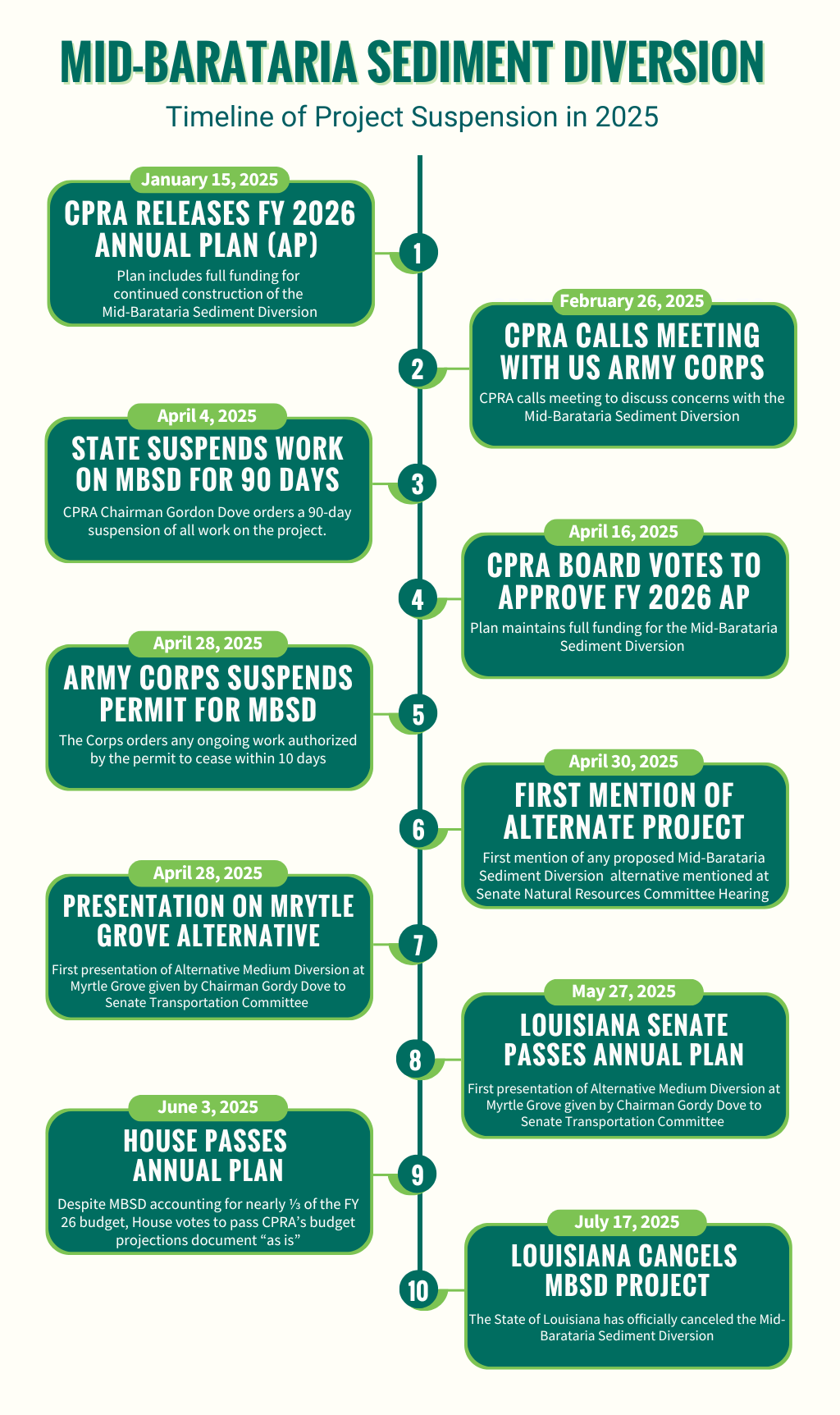Annual Plan Moves Forward. Mid-Barataria Sediment Diversion Left Behind.
Restore the Mississippi River Delta is concerned about Louisiana’s rapidly disappearing coast, and we know you are, too. We want to keep you informed of the most critical issues currently facing our coast.
This blog is part of an ongoing series expressing our concerns about recent shifts in our state’s successful and popular coastal program, including changes to the structure of our coastal program, the protection of coastal funding, and implementation of cornerstone projects in our science-based Coastal Master Plan. Get caught up on the latest developments and learn how you can support the coastal program below.
In this year of significant anniversaries, Hurricanes Katrina, Rita, and the Deepwater Horizon disaster, Louisiana is reminded yet again of our coast’s threatened, fragile nature.
Over the past two decades, Louisiana’s coastal program has been largely shielded from political interference. Five governors, Democrat and Republican, honored our state’s commitment to science, transparency and public input in our coastal planning, setting a national standard for others to admire and emulate.
The organizations that comprise the Restore the Mississippi River Delta coalition – National Audubon Society, Environmental Defense Fund, the National Wildlife Federation and Pontchartrain Conservancy – have supported every Coastal Master and Annual Plan presented to the public since 2007. To date, those planning processes have been informed by the best science and decision-making available to the state. Our coast is dynamic and ever-changing and up-to-date science and engineering are critical, and with limited financial resources the solutions we fund must match the problem.
Louisiana’s coastal program has created a virtuous cycle whereby projects selected from the science-based Coastal Master Plan are built and tangible benefits are delivered to coastal communities. That progress then garners public, political and outside confidence in the program, which unlocks additional funding to build more projects. Those successes and the principles behind them have been hallmarks of Louisiana’s Coastal Program across governors from both parties and legislatures over the past 20 years.
This is no longer the case. That is why Restore the Mississippi River Delta fought to expose the truth of the FY26 Annual Plan.
In the months since the release of the Annual Plan and the subsequent public meetings and committee hearings, it has become clear that those transparent, science-driven processes are not being followed by the current administration, and the FY26 Annual Plan was deliberately inaccurate. While the public was sold an Annual Plan with more than $500 million of construction funding for the Mid-Barataria Sediment Diversion – the largest, most impactful project in the state’s Coastal Master Plan – agency leadership was actively working to kill the project.
In addition to taking credit for expenditures they would never make, the FY26 Annual Plan provided the agency with the budgetary authority to waste more money to reduce the financial liabilities to contractors they created by canceling Mid-Barataria—money explicitly dedicated to restoring injuries from the Deepwater Horizon oil spill.
Adding insult to injury, Chairman Dove also announced the intent to cancel the Mid-Breton Sediment Diversion, effectively ending the CPRA’s longstanding commitment to and reliance on sediment diversions to protect and restore the coast. Again, without any public engagement process or presentation of scientific data or reasoning.
Despite this overt political interference and disregard for science and public trust, the Louisiana Legislature passed the plan during all committee and floor meetings. To read our statement on the passage of the FY26 Annual Plan, click here.
Louisiana has already spent roughly $560 million on the construction of Mid-Barataria, and now the state is simply walking away from the project and abandoning its largest efforts to reconnect the lifeblood of the Mississippi River to the Barataria and Breton basins—projects studied and funded by non-taxpayer dollars.
But this isn’t just about these two critical projects. This is about how Louisiana makes decisions regarding how and where to invest in the protection and restoration of its coast. It is about the integrity of the science and planning that is the foundation for our state’s coastal program and Coastal Master Plan. For 20 years, science-driven decision-making has helped Louisiana prioritize the most effective projects for implementation and secure over $21 billion in funding. If we sacrifice that credibility now, we jeopardize both future funding and our ability to build a more resilient future.
Recent Media:
- Mid-Barataria is key to Louisiana’s Future
- Legislature must demand that Mid-Barataria Diversion proceed, as planned
- Louisiana’s biggest ever coastal project may be dead. Will this old idea replace it?
- Editorial: Coastal restoration is working; let’s not turn back now
- Proponents of Mid-Barataria diversion warn against abandoning wetlands
- Land loss in Louisiana: The fight to preserve our coastline

